Case Study
Forecasting a Downturn in Japanese Yen Futures



Using Socrates to Identify Investing Opportunities
When the Japanese Yen experienced a significant decline in 2021, Socrates Platform users who were studying the market closely could have identified the trends and patterns leading up to this downturn. This case study explains how.
Many users leverage the Socrates Platform to research market activity and identify long-term trading opportunities. However, the platform (Pro and Enterprise) can also be used by advanced users to research short-term trading opportunities.
Here, we demonstrate how Socrates Enterprise enables users to analyze market behavior from a Top-Down approach — yearly time level down to daily — with the proprietary models.
This exercise would have revealed conditions for a potential large move down in Yen futures with minimal support.
A Top-Down Approach: Using the Socrates Platform to Research Japanese Yen Futures
Socrates’ Timing Arrays analyze and aggregate cyclical activity across different time levels, enabling users to perform what we call a ‘top-down’ study. You can do this as a Pro Member, but Enterprise users have unique access to yearly and quarterly Arrays and Reversals for licensed markets, and as you'll see outlined in this case study, that proved valuable when researching Yen futures leading up to the decline in 2021.
Let’s start by exploring the Yearly Timing Arrays for 2020.
The 2020 Socrates Timing Array showed the highest Aggregate bar in 2021, indicating a potential turning point ahead. Looking at the price chart, you can see the Yen Futures have generally been in an upward trend in recent years. The Aggregate bar showing a high for 2021 suggested that the trend may peak and turn bearish, or downward in 2021.
Using Time Arrays
When studying the Timing Arrays it is a best practice to pay particular attention to the Aggregate row as it represents the summation of the entire collection of Time Array models. For the Aggregate bar, blue indicates that the number has increased. Pink indicates a decrease.
Another best practice is to pay the most attention to the first four to six columns. This is because, each column represents a unit of time — such as a future month, quarter, or year — and as it nears, the models have analyzed more data. Each row in the table represents different models, and the bar height reflects a readout from those models.
The Timing Array table provides a forward-looking perspective as produced by the proprietary computer models, and the makeup of the bars in each cell are subject to change until the unit of time has concluded (in other words, a month, a quarter, a year has come to a close).
The first column in the Timing Array table is the most recently closed unit of time, serving as a reference point compared to the rest of the table — it is no longer subject to change like the rest of the columns.

Zooming into the Quarterly time level, the first Quarter starting (labeled January) and the fourth Quarter (labeled October 2021 emerged as relatively significant within that year. They had the largest Aggregate bars respectively. The Socrates Platform’s computer-generated Array Articulation text phrased it in the following way: “On the Quarterly Level, our first target for a turning point is The First Quarter 2021, which is reinforced by a Directional Change Target with the opposite trend thereafter into the Second Quarter 2021 (NOTE: this can be intraday or on a closing basis).”

Based on the Quarterly study so far, we were expecting a potential high and a turning point in the first quarter of 2021. We then moved to the monthly view to further test our hypothesis.
Importance of Monthly Timing Arrays
Within Time Arrays, the Monthly view is the most important - particularly for Pro Members - especially compared with the Weekly and Daily view, as it is less susceptible to short-term noise and false moves. Weekly and Daily Timing Arrays are valuable for advanced users looking for supplemental data points and following a top-down research approach.
Enterprise users can start with Yearly Timing Arrays and research Quarterly, before getting to Monthly.
In either case, starting with the broader, less frequent time levels is what "top-down" means, and then you work down to smaller time levels to see if similar patterns and data support or contradict a thesis.
The Monthly Timing Array highlighted the potential for a relatively significant turning point in January 2021, with a high Aggregate bar reading and strong Empirical signals. The Empirical model identifies potential highs and lows in extremely volatile moves.

Drilling down further to the Weekly level, early January and the beginning of February 2021 stood out as key periods to watch, especially the week starting January 4th — both weeks had high Aggregate signals.

Finally, on the Daily level, January 6th was marked by a high aggregate bar, focusing attention on the price activity of this date.

This analysis provided a picture of how the various proprietary models in the Socrates Timing Arrays were picking up on cyclical activity in the Japanese Yen. But to make effective trades, one must also determine the price movements. For this, we use the Reversal System to understand support, resistance, and inflection points in market price activity.
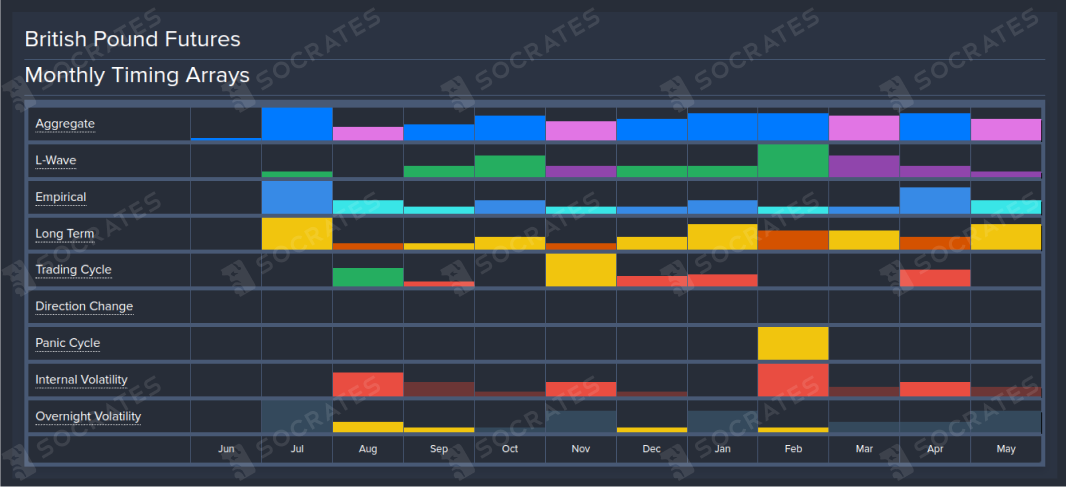
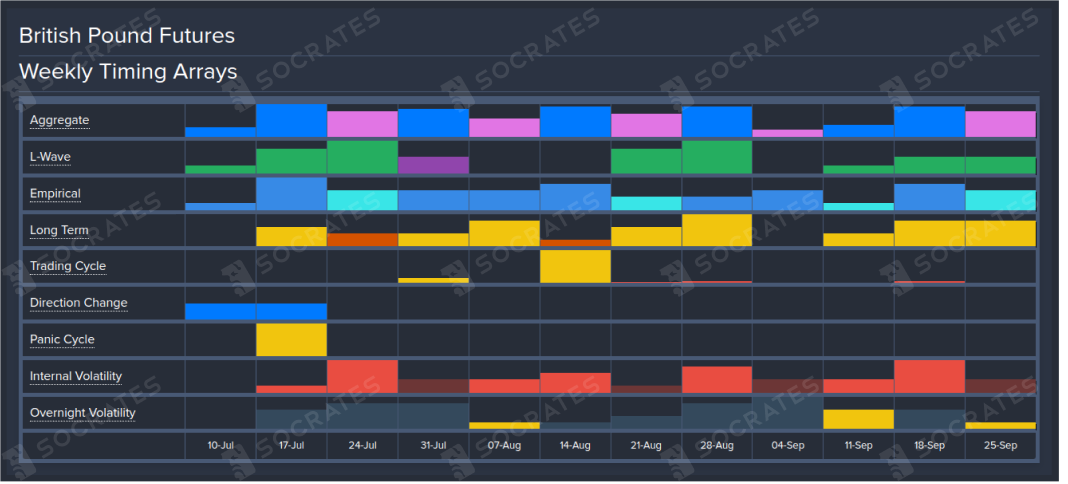
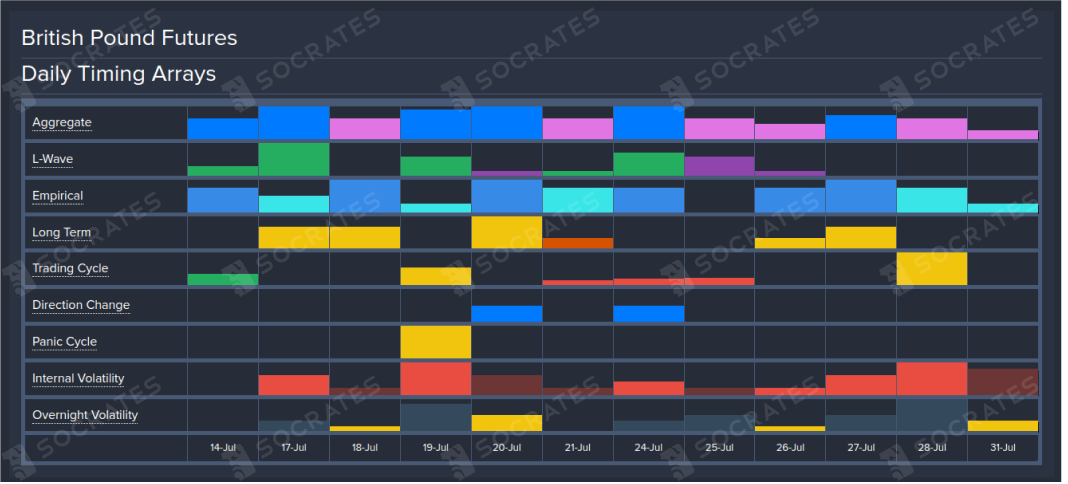
As you can see, the Monthly Timing Arrays indicated a potential turning point for 23 July 2023, with strong signals for the Aggregate, Empirical, Volatility, and Long Term cycles.
The Weekly Timing Array supported the Monthly view. The week of July 17th demonstrated the highest Aggregate bar, with future choppiness suggesting a possible volatile period ahead. The Empirical model further suggested a market reaction and directional change.
Zooming in with the Daily array, July 17th signified the largest Aggregate bar, with July 19th showing a Panic Cycle model reading, and July 20th showing a reading on the Direction Change model.
Note
The Daily time level in the Socrates models is the most susceptible to short-term noise and false moves in a market. One should never solely rely on or heavily weigh the Daily level. It is for advanced users to consider as a supplementary data point in their research.
Uncovering Price Action With the Reversal System
The Reversal System in Socrates helps users identify potential pressure points in price movement. These price points are also known as Reversal points — or more simply as Reversals.
In this case, a close study of the Reversal System, starting with the Yearly time level, could have revealed a key insight for the Japanese Yen Futures: the failure to breach the bullish Reversal in 2021. This is indicated in the area in the chart below, located at 0.009956.
The Yen’s 2020 high was very close to the Reversal point located at 0.0097545. This, and the significant gap between bullish and bearish Reversals — suggesting limited support in between — set the stage for a potentially large price move.


Using the same ‘top-down’ methodology as with the Timing Array system, we can look at the Quarterly price chart to learn more about how the market’s price activity aligned with Reversals. On the Quarterly level, a similar lack of support was observed between Reversals, indicating a consistency across time levels.
From a Monthly point of view, a closer study highlighted that the market encountered some resistance and failed to break through two bullish Reversals in 2020 and closed just below the 0.09699 bullish reversal.

The Weekly level echoed the monthly findings, highlighting the importance of the bullish reversals at 0.09724, where the market failed to break through in the last week of December 2020.

On the Daily level, January 6th saw the Japanese Yen touching but not breaking through two bullish Reversals, reinforcing the strong resistance observed in the Monthly chart. Again, always use caution while studying the Daily time level as it is the most susceptible to short-term noise and false moves in a market. It is a supplementary data point for advanced users only.

Reviewing Patterns from the Global Market Watch
Global Market Watch (GMW) is a proprietary pattern recognition model that offers a broader perspective on market behavior across different time levels.
Now, taking a look at the price pattern recognition from the Global Market Watch (GMW) at the time, both the daily and weekly levels were indicating there may be a temporary high. This aligned with our previous analysis. The model appeared to be picking up on some new patterns on the Monthly and Yearly time levels the Quarterly patterns were showing some possible resistance. This also aligned with our earlier research, that the market may be shifting from a bullish to a bearish trend.

Incorporating the Indicating Ranges into Your Research
The Socrates Platform Indicating Ranges is another independent system that leverages historical data and market behavior to provide a high-level, point-in-time view of a market’s technical and cyclical condition at the time of a session close. This can be a supporting data point when evaluating price activity and its proximity to potential support and resistance levels.
While, in this particular case, the Indicating Ranges don’t directly indicate a market turning point is due, they can play a supplemental role in studying a potential trade or investment idea. The images below represent the status for the Indicating Ranges at the Yearly, Quarterly, Monthly, and Weekly levels.




The Socrates Platform Energy Model is generally used as an additional supplementary data point. It measures the rate of change, or “energy”, in market price movement, helping to identify when a market is potentially reaching a turning point due to overbought or oversold conditions.
In this case, the Energy Model revealed a deceleration in the rate of change when moving from wider (longer) to more narrow (shorter) time levels. While the Monthly level indicated a continuing upward momentum, the shift to negative readings at the Daily and Weekly levels supported our analysis that a potential high will could occur soon.

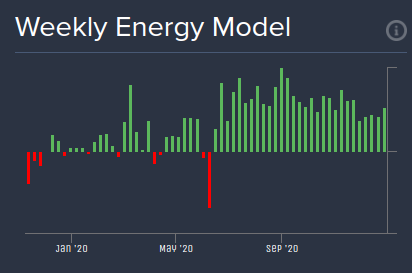
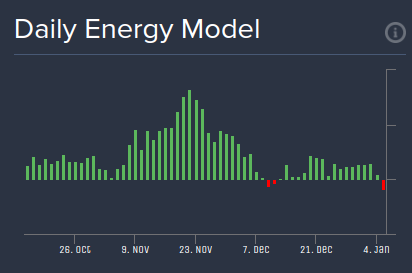
Research that Empowers Financial Decision-Making
To recap, we began with the Timing Arrays, which guided us from 2021 the year, down to Q1, further down to January and February within the Quarter. Our research finally drilled down to January 6th, 2021 as the set-up for a potential turning point.
Once we understood the possible market timing considerations, we used the Reversal System to research price action. This model showed that, in 2020, the market encountered some resistance as not able to exceed some key bullish Reversals. This failure to surpass these levels indicated that the market had perhaps reached a high point. It also indicated the existence of a significant gap between bullish and bearish Reversals further below — suggesting there was limited support if the market turned downward. This picture implied there was potential for a substantial downward movement in the market.
Keep in mind, that the Global Market Watch and Energy Model can both help supplement your research, as they did in this case. These models suggested a bearish trend. Despite the point-in-time Indicating Ranges suggesting a bullish sentiment, researching four of the five computer models in the Socrates Platform indicated a high was possibly in place with bearish conditions ahead.
As this case study outlines, incorporating the Socrates Platform as a tool in a comprehensive approach to market research can provide a strategic advantage and help investors and traders looking to make informed financial decisions. The Socrates Platform can empower users to research global markets and identify both long and short-term opportunities.
IMPORTANT
Socrates is not a financial service, we do not provide financial advice or recommendations. The platform serves as a research tool for informational and educational purposes only.
Is Socrates right for you?
Explore our Membership Plans to find a version of Socrates that works for you. Or check out our guide on Socrates vs. Competitors.